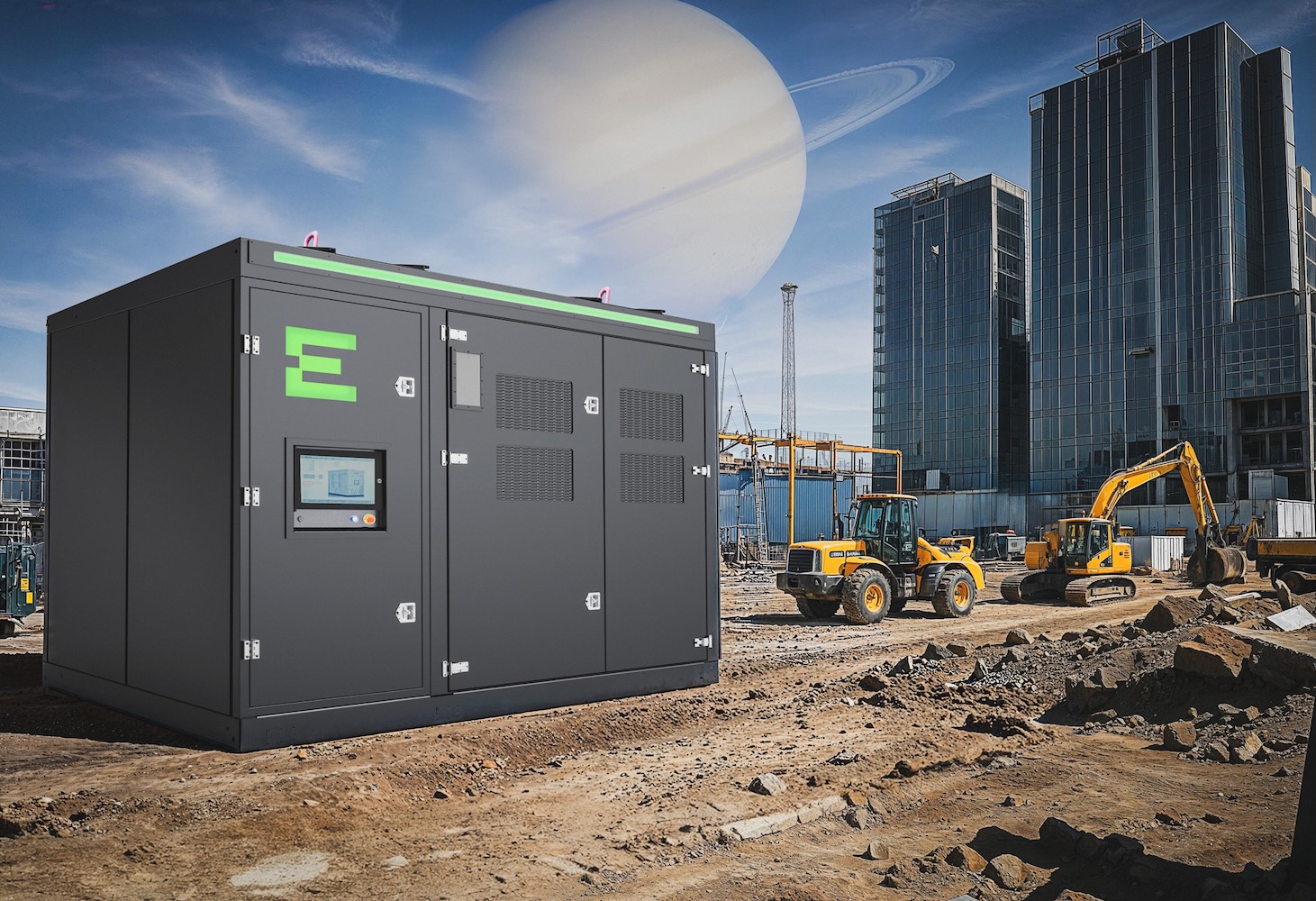Enico|Jupiter
Enemmän kuin sähkövarasto.
Enico Jupiter on modulaarisesti rakentuva sähkövarasto, joka skaalautuu asiakkaan tarpeiden mukaisesti useisiin eri käyttökohteisiin.

Älykäs sähkövarasto osana yrityksen energiastrategiaa tuo kilpailuetua ja kustannustehokkuutta.
Enico | Jupiter sähkövarasto soveltuu moniin eri käyttökohteisiin, aina pienemmistä liike-elämän ja teollisuuden toteutuksista laajamittaisiin järjestelmätason projekteihin. Korkealaatuisiin hallinta- ja energian optimointijärjestelmiin yhdistettynä sähkövarasto soveltuu esimerkiksi energiankulutuksen optimointiin liikerakennuksissa ja teollisuudessa, sähköverkon ja kriittisen infrastruktuurin tukemiseen sekä uusiutuvien energialähteiden käytön tehostamiseen. Sähkövarastoa voidaan hyödyntää myös useissa eri toiminnallisuuksissa rinnakkain.
Enico | Jupiter sähkövarasto soveltuu moniin eri käyttökohteisiin, aina pienemmistä liike-elämän ja teollisuuden toteutuksista laajamittaisiin järjestelmätason projekteihin. Korkealaatuisiin hallinta- ja energian optimointijärjestelmiin yhdistettynä sähkövarasto soveltuu esimerkiksi energiankulutuksen optimointiin liikerakennuksissa ja teollisuudessa, sähköverkon ja kriittisen infrastruktuurin tukemiseen sekä uusiutuvien energialähteiden käytön tehostamiseen. Sähkövarastoa voidaan hyödyntää myös useissa eri toiminnallisuuksissa rinnakkain.
Energiavarasto kaikkiin energianhallintatarpeisiin

Sähkövarastolla optimoit energiaa ja luot arvoa
Energian hallintaa aina kiinteistön energian optimoinnista laajoihin verkkomittakaavan sähkövarastoratkaisuihin. Uusiutuvan energian sovellukset, verkon toiminnan varmistaminen, sähköverkon tukeminen ja latausjärjestelmien optimointi. Vastaa jo tänään huomisen ESG-vaatimuksiin.
Sähkövarasto tuo kustannustehokkuutta ja ansaintaa
Modulaarinen rakenne jolla säästät jopa kymmenkertaisesti infrakustannuksissa ja asennusajassa! Sähkövarastot voidaan liittää energia- ja reservimarkkinapaikoille ja etähallinnan avulla voidaan käydä automaattista reservimarkkinakauppaa – kustannustehokkaasti ja tuottavasti.

01
Skaalautuva modulaarinen rakenne kasvaviin tarpeisiin
Enico | Jupiter on rakenteeltaan modulaarinen ja skaalautuu 300 kW – teho- ja 375 kWh energiaportaissa useisiin megawattiluokan järjestelmiin. Patent Pending -rakenne mahdollistaa jopa kymmenen kertaa nopeamman, kustannustehokkaamman asennuksen.
02
Luotettava teknologia – 100% teknologiasta on eurooppalaista
Suomalainen suunnittelu ja eurooppalaiset komponentit takaavat vähintään 96% käyttöasteen vuositasolla sekä luotettavat palvelu-, huolto- ja varaosasopimukset. Sähkövarasto, joka kestää Pohjoismaiset olot (-35….+40 °C).
03
Oma äly, joka tuo hallinnan ja mahdollistaa ansainnan
Enico EMS on virtuaalinen energianhallintajärjestelmä, joka tuo sähkövarastoon älyn ja ansainnan. EMS mahdollistaa sähkövaraston hyödyntämisen useissa eri toiminnallisuuksissa rinnakkain, myös kaupankäynnissä.
Skaalautuva ja optimoitu alusta teollisuudelle ja energiayhtiöille
Rakenteeltaan ainutlaatuinen (EU-patentti haettu) Enico | Jupiter skaalautuu portaittain. Alkaen 175 kW ja 375 kWh teholuokissa, asiakkaan tarpeiden mukaan, aina laajoihin satojen MW/MWh kokoluokkien järjestelmiin asti.
Täysin eurooppalaista teknologiaa – huippuluokan laitteisto ja ohjelmisto samassa paketissa
Kaikki tarvittava yhdestä järjestelmästä: keskijännitteestä akkuihin
Sisältää integroidun automaation ja tekoälypohjaisen energiakaupan ja joustopalvelun
Minimaalinen tarve infralle ja kaapeloinnille asiakaskohteessa


Haluatko kuulla lisää ainutlaatuisesta
Enico | Jupiter sähkövarastosta?
Asiantuntijamme ovat oppaasi energiatehokkaampaan tulevaisuuteen. Kartoitetaan sopiva ratkaisu yrityksellesi.
Ota meihin yhteyttä – aloitetaan matka kohti kestävämpää huomista.
Enico Jupiter – Energianhallinnan äly, teho ja tulevaisuus.
Jupiter – Eurooppalainen energiavarastoinnin läpimurto
Enico | Jupiter:
Jopa kymmenen kertaa pienemmät infrakustannukset ja nopeampi käyttöönotto
Skaalautuva, modulaarinen rakenne kasvaviin tarpeisiin
300 kW/375 kWh portaittain skaalautuva aina useiden megawattiluokan järjestelmiin. Patent pending -rakenne mahdollistaa nopeamman ja kustannustehokkaamman asennuksen.
Luotettava teknologia – 100% eurooppalaista teknologiaa
Suomalainen suunnittelu ja eurooppalaiset komponentit takaavat vähintään 96% käyttöasteen vuositasolla sekä luotettavat palvelu-, huolto- ja varaosasopimukset.
Oma äly, joka tuo hallinnan ja mahdollistaa ansainnan
Enico EMS (Energy Management System) tuo älyn sähkövarastoon. Mahdollistaa useiden toimintojen hyödyntämisen samanaikaisesti – myös kaupankäynnissä eri markkinoilla.
Energiavarasto, joka vastaa tulevaisuuden tarpeisiin
Vastaa jo tänään tulevaisuuden ESG-vaatimuksiin. Esimerkiksi energian käytön optimointi luo kustannustehokkuutta ja mahdollistaa älykiinteistön, joka kasvattaa omistajarvoa. Huipputehon leikkaus tuo selkeää säästöä ja toimintavarmuutta.
Tekniset tiedot
Enicon suunnittelemat ja valmistamat sähkövarastomoduulit on suunniteltu vaativiin pohjoisen ilmasto- ja ympäristöolosuhteisiin sopiviksi (-35….+40 °C). Jokaisessa moduulissa on huolehdittu riittävästä lämmönhallinnasta (lämmitys/viilennys). Moduulit on suunniteltu ulkokäyttöön ja niiden asennuksen helppouteen on kiinnitetty erityistä huomiota.
Enicolla olemme panostaneet myös turvallisuuteen: oma EMS on tietoturvallinen, NIS2-vaatimusten mukainen ratkaisu ja itse sähkövarastoissa on huipputason palontunnistus ja aerosolipohjainen sammutusjärjestelmä. Käytämme vain Tier 1-tason länsimaisia komponentteja/valmistajia/toimittajia. Toimittajilta löytyy organisaatiot myös Suomesta.
Teho asiakastarpeen mukaisesti 175 kW/400 VAC ja 300 kW/690 VAC portaittain
Energian skaalautuvuus 375 kWh portaittain
Järjestelmien teho- ja energialuokkia kasvatetaan lisäämällä useampia moduuleja peräkkäin
Myös moduulijonoja voidaan asentaa rinnakkain
Pienjännite (VAC 400/690) ja keskijännite (10..33 kV) versiot
Akut: LFP-litiumioniakut, 3-tasoinen akunhallintajärjestelmä (BMS)
IP55-kotelointiluokka ja EI60-luokan paloeriste
Mitat: leveys 2600 mm, korkeus 2900 mm ja pituus alkaen 3500 mm. Suoja-alue asennuksiin 3000 mm, lisäksi voi esiintyä paikallisia vaatimuksia.
Paino riippuu siitä, kuinka monta moduulia sähkövarastossa on alk. 7000 kg ->
Asiakkaamme luottavat meihin




“
Enicon osaaminen ja valmiudet reservimarkkinoille toivat heidät esiin valitessa luotettavaa kumppania. Yhteistyössä ja saman vision jakamisessa nähdään potentiaalia voimakkaalle kasvulle ja valmius reservimarkkinaan mahdollistaa laajemman pohjoismaisen kasvun.
– Jarkko Avikainen, toimitusjohtaja, NSC EnergyOpti Oy

Enico | Jupiter – Eurooppalainen energiavarastoinnin läpimurto on täällä

Enico ja belgialainen AVESTA solmivat strategisen kumppanuuden

Enico ja Rittal tiivistävät yhteistyötään

Enico ja Danfoss solmivat yhteistyösopimuksen

Energiavarastoilla on keskeinen rooli energiamurroksessa
Ota yhteyttä
Enico on oppaasi vihreämpään tulevaisuuteen.
Kuljemme edellä – jotta sinä voit keskittyä oleelliseen. Kuuntelemme, analysoimme ja suosittelemme sähkövarastoratkaisuja, jotka palvelevat parhaiten juuri sinun liiketoimintaasi. Ota yhteyttä, niin suunnitellaan yhdessä ratkaisu, joka vastaa tulevaisuuden tarpeisiin jo tänään.
